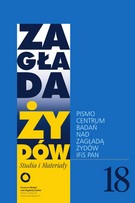Kawalkada interpretacji. Pociąg Kastnera w osobistych narracjach uciekinierów
A cavalcade of interpretations. Kastner's train in escapees' personal narratives
Author(s): Heléna Huhák, András SzécsényiSubject(s): Studies in violence and power, WW II and following years (1940 - 1949), Fascism, Nazism and WW II, History of the Holocaust
Published by: Stowarzyszenie Centrum Badań nad Zagładą Żydów & IFiS PAN
Keywords: self-help; rumor; concentration camp; Kasztner action; Bergen-Belsen; Zionism; Hungarian Holocaust;
Summary/Abstract: The Kasztner train is one of the most well-known episodes of the Hungarian Holocaust. The action played a highly controversial role in the history of the Jewish self-rescue actions that elaborated in recent historiography. Instead of examining the negotiations between the SS and the Hungarian Zionist Rescue Committee, this study explores how the passengers of the Kasztner train narrated their controversial plight in their diaries, memoirs, and interviews. The inquiry seeks to uncover the history of the Kasztner action from a bottom-up perspective focusing on what was the role of news and rumors about the release in the narratives of the survivors. Hungarian Jewish families, i.e. the “Kasztner Jews” aspired to travel to Palestine, landed finally in Switzerland but directly left from Nazi-occupied Hungary to the Bergen- Belsen concentration camp. The majority of them were spending months in a special sector of the camp between June and December 1944. The circumstances in the Hungarian Camp where the inmates were treated as “hostages” by the Nazis were unusual compared to the other – ordinary – camp sectors of Bergen-Belsen or other concentration camps. Due to this special status, the “Kasztner Jews” were not in emergency considering they did not suffer from starvation, aggression, and illnesses that lead to death. However, they were held under Nazi jurisdiction and were imprisoned by the SS, and were not convinced about their longawaited survival. The accounts written during the months spent in Bergen-Belsen shed light on the flow of information between prisoners in a particular situation. Attitudes to the news and interpretations were influenced by the ideological, religious, and personal background of the “Kasztner Jews”. The differences within the group determined the access to information: the Zionist leaders and their families were much more informed but everyone became part of the information network created by the participants to a certain degree. The uncertain plight and the vulnerability to the Nazis evolved ideas and visions of the possible future. The so-called rumor culture was a major phenomenon that featured everyday life. People who were consistently isolated from credible sources of information became both the creators and the consumers of the news. Besides the uncertainty, the moral ambiguity of Kasztner action was reflected in the participants’ narratives. Their attitudes towards the news were largely determined by the conclusions they drew about their own situation and future, which were influenced not only by their political orientation but also by their family situation. The condition of the prisoners from Auschwitz aroused sympathy and pity among them. On the other hand, the poor physical condition of these prisoners reinforced their privileged position. News of potential deportation from Budapest was also at the center of the discussions. Those who feared for their family members and relatives who were on the train and those who stayed in Budapest were trapped. When they heard the good news, they were glad that family members who stayed in Budapest were secure from deportation. At the same time, the distressing news reinforced their decision to leave the country. Diarists and memoirists have struggled to narrate all of this contradictions.
Journal: Zagłada Żydów. Studia i Materiały
- Issue Year: 2022
- Issue No: 18
- Page Range: 322-341
- Page Count: 20
- Language: Polish

